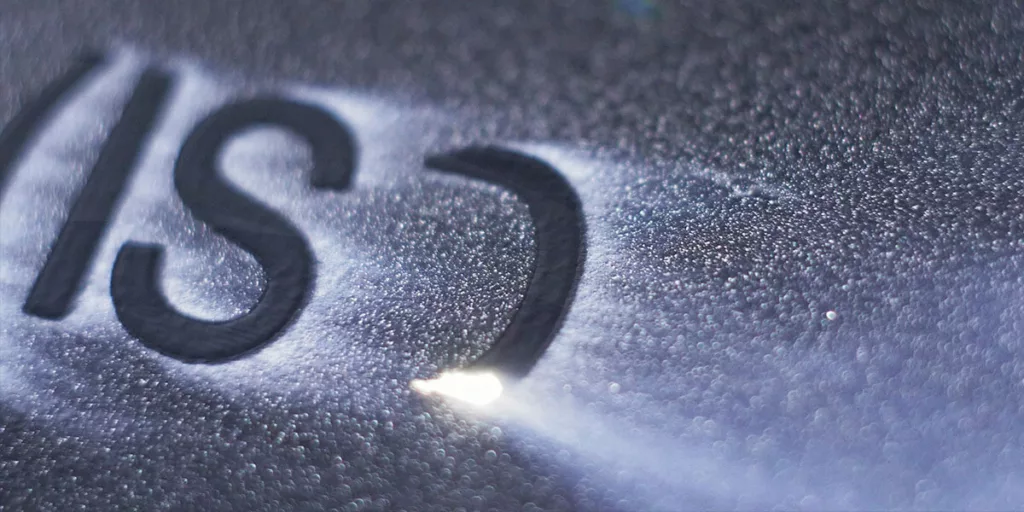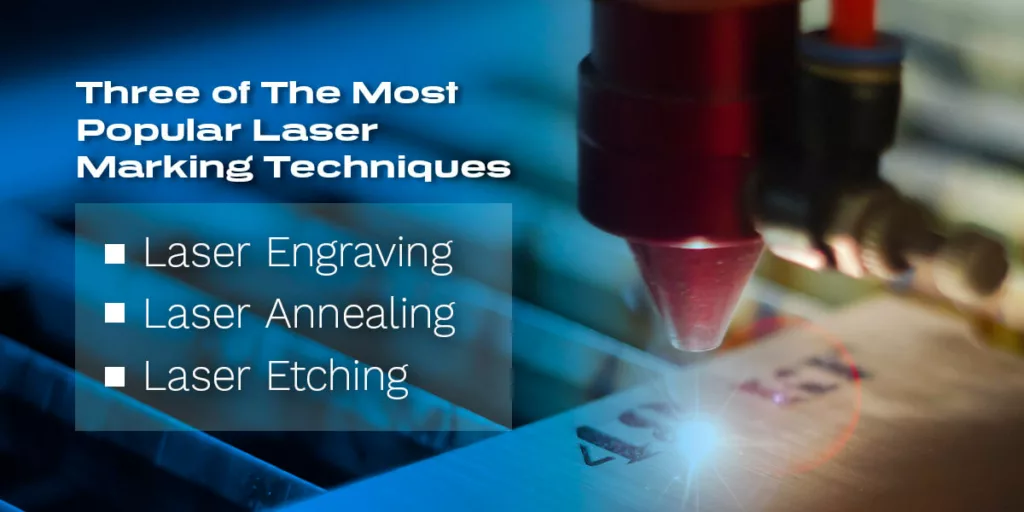
Laser marking is a versatile and exact method of engraving or labeling using concentrated light beams. This technology has gained widespread use across various industries because it creates permanent, high-quality markings without physically touching the material. Unlike traditional methods like etching, stamping or chemical processes, laser marking offers a non-contact, non-abrasive solution that ensures minimal damage to the workpiece.
Understanding industrial laser marking systems can help you find the best method for your needs, allowing you to achieve a seamless design that works well with your operation.
Laser marking operates on the principle of material interaction with intense laser beams. When the laser beam focuses on the material’s surface, it generates heat and causes localized oxidation, vaporization or color change, depending on the material type. The controlled energy input changes the material’s surface properties, resulting in the desired mark, logo, serial number or text. The precise process enables intricate designs and markings, even on small or delicate objects.
Lasers used for marking are highly potent — they require strict safety procedures to protect users from harm. This power is what makes lasers so effective.
Different lasers are suitable for various materials and applications. There are several options available for laser marking — each provides excellent accuracy and quality. Lasers use diverse methods and wavelengths to achieve this effect on other materials, making them a versatile, effective tool. Let’s look at these lasers and what they’re best at.
Fiber laser marking is a widely acclaimed application known for exceptional performance. Fiber lasers use optical fibers covered with rare-earth elements, which amplify the laser light as it passes through. This process produces high power and beam quality, enabling fine and accurate markings. Fiber lasers are particularly adept at marking metals, plastics, ceramics and some organic materials. Their compact size, maintenance-friendly design and energy efficiency make them popular for industrial applications.
CO2 laser marking is another vital technique in the industry. These lasers employ a mixture of carbon dioxide, nitrogen and helium gases to generate a laser beam. CO2 lasers have a longer wavelength, which makes them ideal for marking non-metallic materials like wood, glass, leather, paper and plastics. Their ability to produce deep engravings and intricate designs, combined with their suitability for a wide range of materials, make CO2 lasers indispensable in applications like packaging, signage and artistic creations.
Many people prefer ultraviolet lasers for their shorter, 355nm wavelength, which allows them to create high-precision markings on various materials, such as plastics and some metals. UV lasers can create finer details while reducing the heat-affected zone, making them ideal for marking delicate materials that CO2 lasers might struggle with. Additionally, UV lasers produce high-quality, high-contrast markings, making them ideal for applications where clarity is essential.
Green lasers offer balanced execution for laser marking. Their 532nm wavelength strikes a middle ground between visibility and material absorption, making green lasers effective for many materials, including metals, ceramics and plastics. Green laser systems often provide excellent beam quality and stability, producing consistent marking results.
Several laser marking techniques ensure the best results. These different methods offer unparalleled precision, making them invaluable across industries for their ability to make detailed markings without physical contact. Three of the most popular techniques are laser engraving, laser annealing and laser marking. Look at these techniques to help you find the best method for your needs.

Laser engraving is a technique that involves removing material from the surface to create a mark. The focused laser beam vaporizes the material, creating a visible mark with varying depths. This widely used method is ideal for applications that require durable and distinct markings, such as serial numbers, logos or decorative patterns on metals, ceramics and plastics. Laser engraving’s precision and ability to produce fine details make it a preferred choice for industries seeking intricate designs and clear identification.
Laser annealing is a process that alters the color of a material’s surface without causing significant material removal. It’s particularly effective for metals and alloys, changing their color through controlled heating. A thin oxide layer forms on the surface by heating the material below its melting point, resulting in a contrasting color change. This technique is excellent for medical devices, consumer electronics and automotive parts that require a visually appealing and permanent mark without compromising the material’s integrity.
Laser etching is also known as laser ablation or surface marking. It involves removing a thin material layer from the surface to create a mark. Removing a thin layer leaves a distinct contrast and makes the markings visible on the material. This method relies on precise control of laser parameters to achieve the desired depth and contrast.
Laser etching can also create raised surfaces — adjusting the laser’s power, speed and focus allows you to remove material from specific areas while leaving adjacent regions untouched. This controlled material removal generates a raised profile that adds dimension to the surface. The result is a distinct contrast between the raised and recessed areas, enhancing the marked object’s visual and tactile experience.
Laser etching is versatile and can mark a wide range of materials, including plastics, glass, ceramics and metals. It’s common in the electronics, aerospace and jewelry industries — areas where intricate markings, like barcodes, branding and traceability, are essential.
Laser marking has widespread applications in various industries, providing precise and permanent marking solutions for different materials. Notably, the automotive, medical device and firearm manufacturing industries have all harnessed laser marking’s capabilities to improve product identification and traceability, as well as functionality.
Laser marking is pivotal in enhancing vehicle efficiency, safety and aesthetics in the automotive industry. Lasers precisely mark components such as engine parts, chassis and critical safety elements. These markings ensure proper assembly, accurate identification and traceability throughout the manufacturing and maintenance processes. Laser marking enables car manufacturers to meet industry standards, regulatory requirements and customer demands for durable and tamper-proof markings on components and parts.
Laser marking is critical for the medical device manufacturing industry. Medical devices often require intricate and durable markings, from serial numbers and production dates to lot numbers and regulatory information. Laser marking ensures these markings remain clear, readable and resistant to wear and sterilization processes. This technique’s non-contact nature also minimizes contamination risks and damage to sensitive medical equipment. This technology contributes to patient safety, regulatory compliance and efficient inventory management within the medical field.
Firearm manufacturing heavily relies on laser marking for functional and legal requirements. Laser markings on firearms include serial numbers, manufacturer information and other identifying details mandated by government regulations for tracking purposes. These markings are crucial for tracking firearms throughout their life span, aiding law enforcement agencies in investigations and preventing illegal trade. Laser marking’s precision and permanence ensure the markings remain legible and resistant to wear, even under harsh conditions.